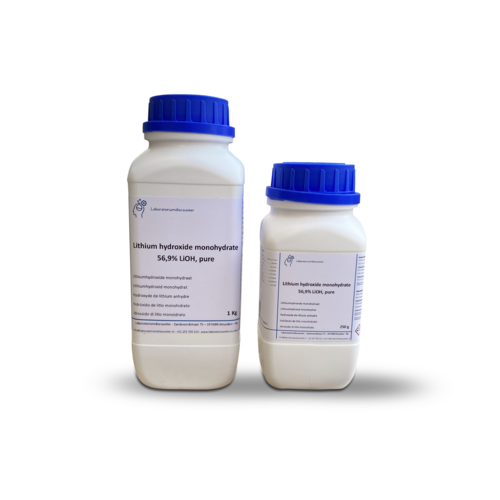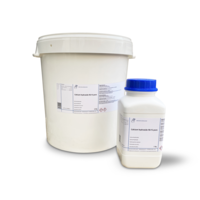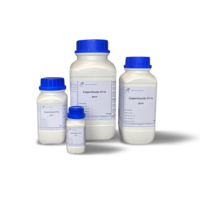You have no items in your shopping cart
Lithium hydroxide monohydrate, pure
- Buy 6 and save 5%
What is Lithium Hydroxide?
Lithium hydroxide LiOH, the hydroxide of lithium, is a strong base, but only sparingly soluble in water.
What is Lithium Hydroxide used for?
Most lithium hydroxide is used in the production of lithium stearates and lithium 12-hydroxystearate, which are important automotive and aircraft lubricating greases. It is also used as an air purifier due to its carbon dioxide binding effect. This is especially important in aerospace, on submarines and with pendulum breathing apparatus (rebreather). Lithium hydroxide can be added to cement and can suppress the alkali-silica reaction. Lithium hydroxide is also a potential additive in nickel-iron batteries.
In pressurized water reactors, lithium hydroxide is added to the primary circuit to neutralize boric acid and achieve a pH of about 7.2.
Lithium hydroxide is also used as a raw material in the manufacture of car batteries.
Other areas of application are photodevelopers, ceramic products and the production of borates.
What Safety Precautions Should I Take Before Using Chemicals?
It is always wise to work as safely as possible when working with chemicals. Even substances that do not seem dangerous at first can cause enormous damage if they get into your eyes. Therefore, always wear safety goggles. You also want to prevent chemicals from ending up on your skin, which is why it is important to always use good gloves or disposable gloves.
Respiratory protection is necessary for volatile substances, vaporous liquids and solids that dust. There are many different types of filters, so you should always refer to the MSDS to find out which filter you need. Many filters also specify which substances they are for.
In some cases it may be necessary to protect the whole body, in which case a plastic overall is needed, you can find it here.
When working with flammable and oxidizing substances, it is important to always have fire extinguishers and absorbents at hand. It is also useful to be able to clean up spills of aggressive chemicals immediately with absorbents and to dispose of them in accordance with international and/or local legislation.
If you need more information on how to handle a specific substance, always consult the safety data sheet. You can find this on the product page or request it via [email protected]
Technical properties
Empirical formula LiOH · H2O
Molar mass (M) 41,96 g/mol
Density (D) 1,51 g/cm³
Melting point (mp) 424 °C
ADR 8 II
WGK 1
CAS No. [1310-66-3]
EG-Nr. 215-183-4
UN-Nr. 2680
Downloads
$$$$$
Hazard statements
H302 Harmful if swallowed
H314 Causes severe burns and eye damage
Precautions - prevention
P261 Avoid breathing dust.
P270 Do not eat, drink or smoke when using this product.
P280 Wear protective gloves / eye protection.
Precautions - response
P302 + P352 IF ON SKIN: Wash with plenty of water.
P305 + P351 + P338 IF IN EYES: Rinse cautiously with water for a period of time
amount of minutes; remove contact lenses, if possible; keep rinsing.
P310 Immediately call a POISON CENTER / doctor.











